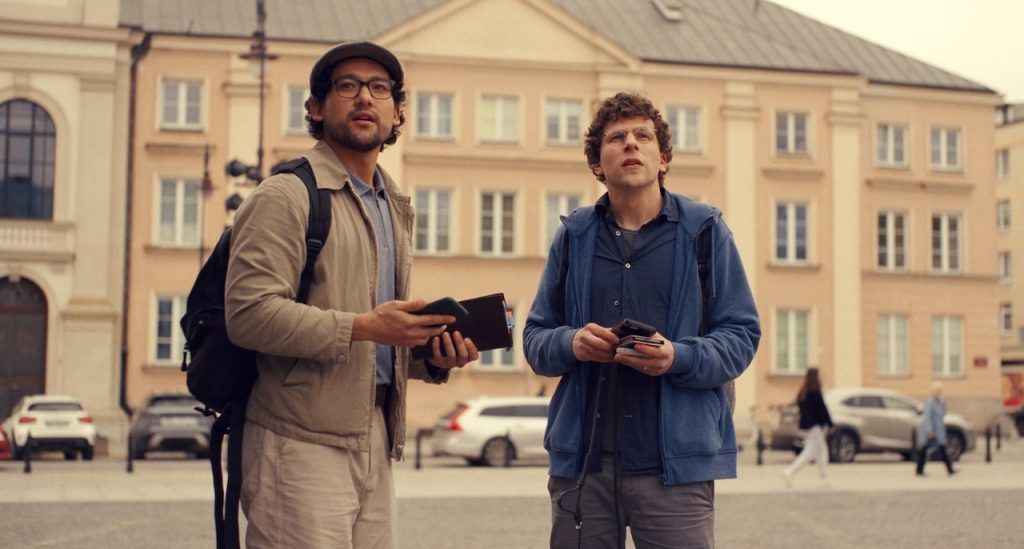What if history was different?
It all began when Jesse Eisenberg, visited a tiny ancestral house in the Polish village of Kranystaw where his aunt Doris used to live before her entire family was uprooted during the Holocaust.
“What would my life be like? Who would I be?” ponders Eisenberg during that visit. “Had the war not happened, this is where I would be living?”
These existential questions would inspire an off-Broadway play called The Revisionist in 2013, and eventually, a film called A Real Pain. Eisenberg toiled for almost fifteen years to adapt the story into a viable screenplay. The play centered on a young American visiting his Polish cousin, a Holocaust survivor making a pilgrimage to the motherland. This event formed a key cornerstone for the movie. However, Jesse needed another angle into the film. It had to be more than depicting the horrors of the war.
In between Jesse’s multiple unsatisfactory film adaptations, he wrote a short story for Tablet magazine about two guys going to Mongolia. Although unrelated to his play or screenplay, the story inspired the buddy component of A Real Pain. Jesse persevered with rearranging his index cards until he decided his movie was going to be a buddy story about two cousins set in Poland to honor their deceased grandmother.
Holocaust Tours – With Lunch
Fortuitously, Eisenberg stumbled across an ad while in Poland advertising “Holocaust tours.” This piqued his interest since it would add gravity and context to the place where his grandmother perished.
“The tour took me through the Holocaust sites of Poland — but with all of the creature comforts that an upper middle class American tourist would want. I read the ad with a mix of awe and shock. I thought that is a phenomenal framework to set this movie,” shares Jesse.
Now that the building blocks of A Real Pain were set, Eisenberg set out writing yet another draft about two cousins Benji (Kieran Culkin) and David (Jesse Eisenberg), the once-tight cousins who drifted apart because life got in the way. They are reunited during a trip to Poland to honor their grandmother and the appreciate the horrors her entire family faced, while rediscovering their love of each other. Despite their antithetical views on life, they try to figure out if they can salvage or even resurrect their once unbreakable bond.

James (Will Sharpe) and David (Jesse Eisenberg). Photo Courtesy of Searchlight Pictures
The seeds of the significance of the seemingly innocuous title are also planted in this character study.
Benji is a stoner with few life goals. He lives for the present and takes each carefree day as it comes. David is the meticulous planner who works in sales with a wife and child in Brooklyn, New York.
Ironically, Eisenberg initially wrote Benji’s character for himself, but opted for the role which is less like his true self.
Themes In A Real Pain
David grapples with the emotional pain of confronting his family history. “He’s questioning what is real and valid pain when you’re visiting the sites of genocide? Is David’s general anxiety disorder valid even though his cousin is experiencing something far worse? That’s what the movie is questioning,” explains Eisenberg.
Both David and Benji are steeped in deep emotional pain, but dealing with it very differently. David is annoyingly neurotic and buttoned-down while Benji is annoyingly freewheeling and upbeat. Both are suffering some level of depression and trauma.
Benji is the more textured character as his happy-go-lucky facade conceals his struggles. He’s sensitive and insensitive, affable and sarcastic, quiet and talky. His mood shifts without warning as cracks appear. As Jesse Eisenberg puts it, “Benji is hard to nail down or fully understand.”
The tour group launches the road movie segment of the film. The tour guide is James (Will Sharpe) who offers a matter-of-fact, Wikepedia-style, academic tour of historical places. He delivers facts, figures, and dates in a way someone might read a grocery list.
Benji challenges James on his even-tempered, emotionally-disconnected approach to the tour. The true significance of a place is only revealed when there is an emotional context and story behind it to make it resonate.
Eisenberg, who also directed, sought to instill “the quiet unease” of a tour fraught with so much horrific history. He looked to films like Alfonso Cuarón’s Y Tu Mama Tambien to capture the road movie visual style. He wanted to illustrate Poland’s beauty, but add gray shades of horror and history to it.
Improvising In A Tight Script
Drawing on Jesse and Kieran’s theater roots, Eisenberg encouraged the cast to improvise even within the finely-tuned screenplay. Jesse suggested loosening the strings. This led to some humorous moments including the tour scene where the group is mimicking the poses of the statues in a World War II memorial while taking holiday snaps.
Jesse Eisenberg deliberately avoids A Real Pain falling victim to mawkish earnestness. Audiences, especially those with a personal connection to the Holocaust, should experience the movie in their own way, just like Jesse.
